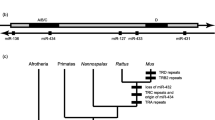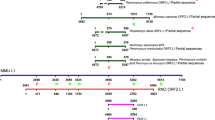Abstract
Ty3/gypsy retrotransposons are rare in mammalian genomes despite their abundance in invertebrate and other vertebrate classes. Here we identify a family of nine conserved mammalian genes with homology to Ty3/gypsy retrotransposons but which have lost their ability to autonomously retrotranspose. Of these, five map to the X chromosome while the remaining four are autosomal. Comparative phylogenetic analyses show them to have strongest homology to the sushi-ichi element from Fugu rubripes. Two of the autosomal gene members, Peg10 and Rtl1, are known to be imprinted, being expressed from the paternally inherited chromosome homologue. This suggests, consistent with the host-parasite response theory of the evolution of the imprinting mechanism, that parental-origin specific epigenetic control may be mediated by genomic “parasitic” elements such as these. Alternatively, these elements may preferentially integrate into regions that are differentially modified on the two homologous chromosomes such as imprinted domains and the X chromosome and acquire monoallelic expression. We assess the imprinting status of the remaining autosomal members of this family and show them to be biallelically expressed in embryo and placenta. Furthermore, the methylation status of Rtl1 was assayed throughout development and was found to resemble that of actively, silenced repetitive elements rather than imprinted sequences. This indicates that the ability to undergo genomic imprinting is not an inherent property of all members of this family of retroelements. Nonetheless, the conservation but functional divergence between the different members suggests that they have undergone positive selection and acquired distinct endogenous functions within their mammalian hosts.






Similar content being viewed by others
References
Arnaud P, Monk D, Hitchins M, Gordon E, Dean W, Beechey CV, Peters J, Craigen W, Preece M, Stanier P, Moore GE, Kelsey G (2003) Conserved methylation imprints in the human and mouse GRB10 genes with divergent allelic expression suggests differential reading of the same mark. Hum Mol Genet 12:1005–1019
Barlow DP (1993) Methylation and imprinting: from host defense to gene regulation? Science 260:309–310
Bell AC, Felsenfeld G (2000) Methylation of a CTCF-dependent boundary controls imprinted expression of the Igf2 gene. Nature 405:482–485
Birchler JA, Bhadra MP, Bhadra U (2000) Making noise about silence: repression of repeated genes in animals. Curr Opin Genet Dev 10:211–216
Butler M, Goodwin T, Simpson M, Singh M, Poulter R (2001) Vertebrate LTR retrotransposons of the Tf1/sushi group. J Mol Evol 52:260–274
Chai JH, Locke DP, Ohta T, Greally JM, Nicholfs RD (2001) Retrotransposed genes such as Frat3 in the mouse Chromosome 7C Prader-Willi syndrome region acquire the imprinted status of their insertion site. Mamm Genome 12:813–821
Chesnokov IN, Schmid CW (1995) Specific Alu binding protein from human sperm chromatin prevents DNA methylation. J Biol Chem 270:18539–18542
Ferguson-Smith AC, Sasaki H, Cattanach BM, Surani MA (1993) Parental-origin-specific epigenetic modification of the mouse H19 gene. Nature 362:751–755
Gdula DA, Gerasimova Tl. Corces VG (1996) Genetic and molejajjiar analysis of the gypsy chromatin insulator of Drosophila. Proc Natl Acad Sci USA 93:9378–9383
Hark AT, Tilghman SM (1998) Chromatin conformation of the H19 epigenetic mark. Hum Mol Genet 7:1979–1985
Hata K Sakaki Y (1997) Identification of critical CpG sites for repression of L1 transcription by DNA methylation. Gene 189:227-234
Hirotsune S, Yoshida N, Chen A, Garrett L, Sugiyama F, Takahashi S, Yagami K, Wynshaw-Boris A, Yoshiki A (2003) An expressed pseudogene regulates the messenger-RNA stability of its homologous coding gene. Nature 423:91–96
Kato MV, Ikawa Y, Hayashizaki Y, Shibata H (1998) paternal imprinting of mouse serotonin receptor 2A gene Htr2 in embryonic eye: a conserved imprinting regulation on the RB/Rb locus. Genomics 47:146-148
Lander ES, Linton LM, Birren B, Nusbaum C, Zody MC, Baldwin J, Devon K, Dewar K, Doyle M, FitzHugh W, Funke R, Gage D, Harris K, Heaford A, Howland J, Kann L, Lehoczky J, LeVine R, McEwan P, McKernan K, Meldrim J, Mesirov JP, Miranda C, Morris W, Naylor J, Raymond C, Rosetti M, Santos R, Sheridan A, Sougnez C, Stange-Thomann N, Stojanovic N, Subramanian A, Wyman D, Rogers J, Sulston J, Ainscough R, Beck S, Bentley D, Burton J, Clee C, Carter N, Coulson A, Deadman R, Deloukas P, Dunham A, Dunham I, Durbin R, French L, Grafham D, Gregory S, Hubbard T, Humphray S, Hunt A, Jones M, Lloyd C, McMurray A, Matthews L, Mercer S, Milne S, Mullikin JC, Mungall A, Plumb R, Ross M, Shownkeen R, Sims S, Waterston RH, Wilson RK, Hillier LW, McPherson JD, Marra MA, Mardis ER, Fulton LA, Chinwalla AT, Pepin KH, Gish WR, Chissoe SL, Wendl MC, Delehaunty KD, Miner TL, Delehaunty A, Kramer JB, Cook LL, Fulton RS, Johnson DL, Minx PJ, Clifton SW, Hawkins T, Branscomb E, Predki P, Richardson P, Wenning S, Slezak T, Doggett N, Cheng JF, Olsen A, Lucas S, Elkin C, Uberbacher E, Frazier M, et al. (2001) Initial sequencing and analysis of the human genome. Nature 409:860–921
Lane N, Dean W, Erhardt S, Hajkova P, Surani A, Walter J, Reik W (2003) Resistance of IAPs to methylation reprogramming may provide a mechanism for epigenetic inheritance in the mouse. Genesis 35:88–93
Liu WM, Maria RJ, Rubin CM, Schmid CW (1994) Alu transcripts: cytoplasmic localisation and regulation by DMA methylation. Nucleic Acids Res 22:1087–1095
Lynch C, Tristem M (2003) A co-opted gypsy-type LTR-retrotransposon is conserved in the genomes of humans, sheep, mice, and rats. Curr Biol 13:1518–1523
Matzke MA, Aufsatz W, Kanno T, Mette MF, Matzke AJ (2002) Homology-dependent gene silencing and host defense in plants. Adv Genet 46:235–275
Miller K, Lynch C, Martin J, Herniou E, Tristem M (1999) Identification of multieje Gypsy LTR-retrotransposon lineages in vertebrate genomes. J Mol Evol 49:358–366
Nagasaki K, Schem C, von Kaisenberg C, Bialiek M, Rosel F, Jonat W, Maass N (2003) Leucine-zipper protein. LDOC1, inhibits NF-kappaB activation and sensitizes pancreatic cancer cells to apoptosis. Int J Cancer 105:454–458
Nagase T, Kikuno R, Ishikawa Kl. Hirosawa M, Ohara O (2000) Prediction of the coding sequences of unidentified human genes. XVI. The complete sequences of 150 new cDNA clones from brain which code for large proteins in vitro. DNA Res 7:65–73
Nicholas KB, Nicholas HB, Deerfield DW (1997) Genedoc: analysis and visualisation of genetic variation. EMBNEW.NEWS 4:14
Okabe H, Satoh S, Furukawa Y, Kato T, Hasegawa S, Nakajima Y, Yamaoka Y, Nakamura Y (2003) Involvement of PEG10 in human hepatocellular carcinogenesis through interaction with SIAH1. Cancer Res 63:3043–3048
Ono R, Shiura H, Aburatani H, Kohda T, Kaneko-Ishino T, Ishino F (2003) Identification of a large novel imprinted gene cluster on mouse proximal chromosome 6. Genome Res 13:1696–1705
Pesce M, De Felici M (1995) Purification of mouse primordial germ cells by MiniMACS magnetic separation system. Dev Biol 170:722–725
Rubin CM, VandeVoort CA, Teplitz RL, Schmid CW (1994) Alu repeated DNAs are differentially methylated in primate germ cells. Nucleic Acids Res 22:5121–5127
Saitou N, Nei M (1987) The neighbor-joining method; a new method for reconstructing phylogenetic trees. Mol Biol Evol 4:406–425
Sanford JP, Clark HJ, Chapman VM, Rossant J (1987) Differences in DNA methylation during oogenesis and spermatogeneis and their persistence during early embryogenesis in the mouse. Genes Dev 1:1039–1046
Schwartz S, Kent WJ, Smit A, Zhang Z, Baertsch R, Hardison RC, Haussler D, Miller W (2003) Human-mouse alignments with BLASTZ. Genome Res 13:103–107
Seitz H, Youngson N, Lin SP, Dalbert S, Paulsen M, Bachellerie JP, Ferguson-Smith AC, Cavaille J (2003) Imprinted microRNA genes transcribed antisense to a reciprocally imprinted retrotransposon-like gene. Nat Genet 34:261–262
Shigemoto K, Brennan J, Walls E, Watson CJ, Stott D, Rigby PW, Reith AD (2001) Identification and characterisation of a developmental regulated mammalian gene that utilises-1 programmed ribosomal frameshifting. Nucleic Acids Res 29:4079–4088
Smallwood A, Papageorghiou A, Nicolaides K, Alley MK, Jim A, Nargund G, Ojha K, Campbell S, Banerjee S (2003) Temporal regulation of the expression of syncytin (HERV-W), maternally imprinted PEG10, and SGCE in human placenta. Biol Reprod 69:286–293
Smith RJ, Dean W, Konfortova G, Kelsey G (2003) Identification of novel imprinted genes in a genome-wide screen for maternal methylation. Genome Res 13:558–569
Spana C, Harrison DA, Corces VG (1988) The Drosophila melanogaster suppressor of Hairy-wing protein binds to specific sequences of the gypsy retrotransposon. Genes Dev 2:1414–1423
Steplewski A, Krynska B, Tretiakova A, Haas S, Khalili K, Amini S (1998) MyEF-3, a developmental controlled brain-derived nuclear protein which specifically interacts with myelin basic protein proximal regulatory sequences. Biochem Biophys Res Commun 243:295–301
Takada S, Paulsen M, Tevendale M, Tsai CE, Kelsey G, Cattanach BM, Ferguson-Smith AC (2002) Epigenetic analysis of the Dlk1-Gtl2 imprinted domain on mouse chromosome 12: implications for imprinting control from comparison with Igf2-H19. Hum Mol Genet 11:77–86
Takagi N, Sasaki M (1975) Preferential inactivation of the paternally derived X chromosome in the extraembryonic membranes of the mouse. Nature 256:640–642
Volff J, Korting C, Schartl M (2001) Ty3/Gypsy retrotransposon fossils in mammalian genomes: did they evolve into new cellular functions? Mol Biol Evol 18:266–270
Walsh CP, Chaillet JR, Bestor TH (1998) Transcription of IAP endogenous retroviruses is constrained by cytosine methylation. Nat Genet 20:116–117
Walter J, Paulsen M (2003) The potential role of gene duplications in the evolution of imprinting mechanisms. Hum Mol Genet 12 Spec No 2:R215–220
Yoder JA, Walsh CP, Bestor TH (1997) Cytosine methylation and the ecology of intragenomic parasites. Trends Genet 13:335-340
Acknowledgments
This study was supported by a PhD studentship from the BBSRC (N.A.Y.) and Wellcome Trust (N.P.) and by a grant from CR-UK. We thank Shuji Takada and Philippe Arnaud for help with the methylation analyses, Sarah Bray for assistance with the phylogenetic analysis, and Takashi Sado and Simão Rocha for technical assistance. We are grateful to Joanna Maldonado-Saldivia and Azim Surani for e11.5 primordial germ cells.
Author information
Authors and Affiliations
Corresponding author
Additional information
The sequence data from this study have been submitted to Entrez/NCBI under accession nos. XXXXXX to XXXXXXX.
[Reviewing Editor : Dr. Juergen Brosius]
Rights and permissions
About this article
Cite this article
Youngson, N.A., Kocialkowski, S., Peel, N. et al. A Small Family of Sushi-Class Retrotransposon-Derived Genes in Mammals and Their Relation to Genomic Imprinting. J Mol Evol 61, 481–490 (2005). https://doi.org/10.1007/s00239-004-0332-0
Received:
Accepted:
Published:
Issue Date:
DOI: https://doi.org/10.1007/s00239-004-0332-0




